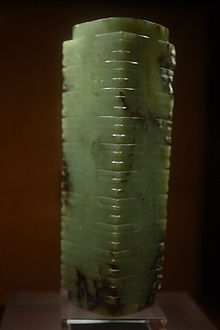- Cong (jade)
-
Cong issu du site archéologique de Jinsha

En archéologie chinoise, le terme Cong (chinois: 琮; pinyin: cóng) désigne un objet de jade sculpté, de forme tubulaire, datant de l'âge néolithique.
Les plus anciens datent de la culture Liangzhu (3400-2250 av. J-C), qui en a produit en grand nombre. On en trouve encore sous les dynasties Shang et Zhou.
Sa spécificité réside dans l'imbrication de deux formes : sa section externe est carrée mais sa section interne est ronde. Par ailleurs, sa surface est décorée de différents niveaux ou registres représentant de façon stylisée des masques d'homme-dieu ou d'animal mythique.
Le plus souvent découvert en contexte funéraire, associé à d'autres artefacts de jade (disques bi, haches), il semble avoir rempli une fonction rituelle, que l'on ne connaît pas précisément. Les Rites des Zhou l'associe symboliquement à la terre, tandis que le disque bi représente le ciel.
La variété de jade utilisée est la néphrite, comme pour tous les jades chinois de la période archaïque.
Indications bibliographiques
Les jades néolithiques chinois / [contributions de Christophe Comentale, Laurent Long, Tong Peihua, Zhang Jingguo] ; [pour l'ACI Du chopper au brillant], [Paris] : Museum national d'histoire naturelle, cop. 2008, 1 vol. (81 p.) : ill., couv. ill. ; 30 cm
Art et archéologie : la Chine du Néolithique à la fin des Cinq Dynasties, 960 de notre ère / Danielle Elisseeff ; Paris : École du Louvre : RMN, 2008
"Neolithic Chinese Jades", Angus Forsyth, in Jade. Ed. Roger Keverne. New York: Van Nostrand Reinhold, 1991. pp. 88-109.
Liens externes
Catégories :- Art en Chine
- Rite funéraire
- Artéfact archéologique
Wikimedia Foundation. 2010.

